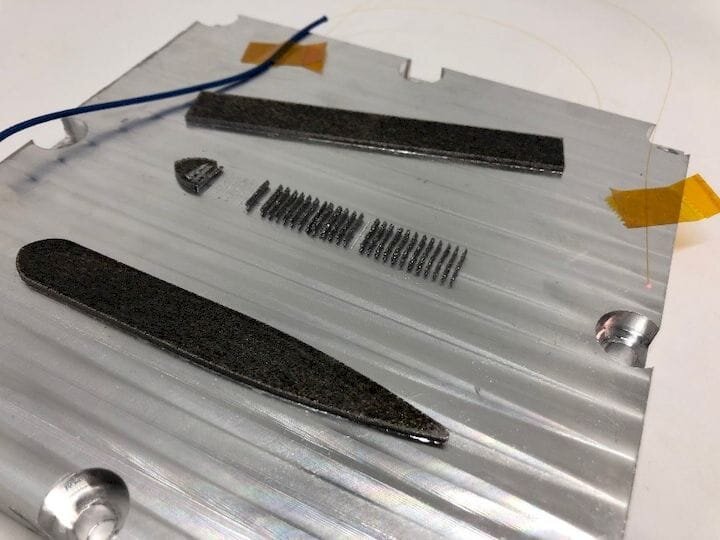![A smart build plate for metal 3D printers [Source: Fabrisonic]](https://fabbaloo.com/wp-content/uploads/2020/05/image-asset_img_5eb08e995732a.jpg)
Fabrisonic has produced an experimental “smart” build plate for metal 3D printers.
This is a very curious development, because Fabrisonic’s unusual metal 3D printing process does not require a build plate at all. It seems they are using their process to create a solution for those using standard powder bed / laser metal 3D printing processes.
Powder Bed / Laser Metal 3D Printing
First, let’s back up and understand the powder bed / laser process, if you’re not familiar with it.
In this process, a powerful laser sweeps across a flat bed of fine metal powder, selectively fusing sections of the powder. When complete, a blade smoothes out a fresh layer of powder on top, and the process repeats. This gradually creates a fully solid 3D metal object, but it’s buried in metal powder at completion.
The process starts with a heavy, flat “build plate”, typically made of the same metal the print is being produced with. The first layer of the print is essentially welded to the build plate. Thus the print must be cut off of the build plate after printing.
This process is very popular and is used in most of the metal 3D printers you see on the market today. However, there are huge operational challenges in getting it to work correctly, mostly due to thermal issues.
Metal 3D Printer Thermal Challenges
The problem is that the heat required to melt the powder is intense, and this heat subsequently disperses into the surrounding powder and especially any printed elements or support structures.
This stray heat causes warping and tension within the printed structure. It’s so bad that in some cases the print will suddenly warp when cut from the build plate as tension is released.
Operators using sophisticated software can plan for this so that the object is printed in a warped shape, but snaps into a correct configuration when released. It’s a very complex aspect of metal 3D printing, and engineers operating the equipment don’t always succeed.
Fabrisonic Ultrasonic Process
That’s where Fabrisonic’s new smart build plate comes in.
The company produces a metal 3D printer, but it does not use lasers or powder. Instead they use ultrasonic vibrations to fuse thin sheets of metal together. It’s a very unusual process that allows, for example, the mixing of different materials (sheets) in the same object that might not be feasible in other processes.
Their process also allows embedding of other components within a print, as there is no heat to destroy delicate electronics, for instance.
Recently Fabrisonic has been working on developing embedded strain sensors for an aerospace client. But then they had a fabulous idea to redeploy this technique to aid powder bed / laser metal 3D printing. They saw the following issues in typical metal 3D printing operations:
-
Parts can debond or delaminate from the build plate during printing, which can be difficult to detect since the part is buried in powder.
-
Build plates distort due to build up residual stress.
-
Build plate bolts break from excess residual stress during a build.
-
We don’t understand how stress builds up around individual parts during a build leading to distorted final parts.
Creating a Smart Metal 3D Print Build Plate
They attempted to build a “smart” build plate by embedding a fiber optic sensor and were very surprised by the results. They explain:
“Resolution and scan rate were high enough to actually discern the scan strategy of each layer. Defects showed up as large compressive strains forming early in the build at localized points. Slow delamination of a specific feature could be seen in the data although the recoater blade never hit the build.”
This is quite incredible, as it effectively puts “eyes” on the previously invisible process of metal 3D printing.
Smart 3D Print Build Plate Effects
If they are able to commercialize this technology and install it within metal 3D printers, we could see a number of effects:
-
Reduced number of failed metal 3D print jobs
-
Reduced loss of expensive metal powder in failed print jobs
-
Easier quality control for volume prints
-
More intelligent metal 3D print job configurations through observation of prior jobs
-
Reduced part costs to the end user
Fabrisonic seems to be still developing this technology, and I suspect there is a lot more that can be gained yet, particularly if sophisticated software can be created to work with the sensor data.
Via Fabrisonic

